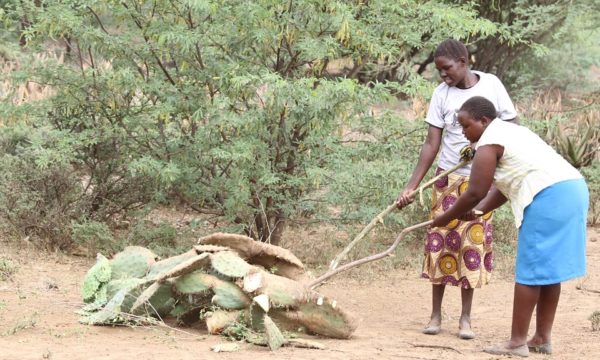
A Prosopis clearing along the Awash river
CABI scientists have revealed the massive ecological and economic impacts that the invasive alien tree Prosopis juliflora has had across the Afar Region of north eastern Ethiopia.
Dr Urs Schaffner, who is supervising lead author Mr Hailu Shiferaw for his PhD studies, contributed to the Science of The Total Environment published research which shows that the devastating Prosopis was a major reason for losses in annual ecosystem service values in Afar Region estimated at US $602 million in just 31 years.
Mr Shiferaw, in the paper entitled ‘Implications of land use/land cover dynamics and Prosopis invasion on ecosystem service values in Afar Region, Ethiopia’, highlighted that between 1986 and 2017 the weed spread at a rate of 31,127 ha/year while grassland and bush-shrub-woodland declined at a rate of 19,312 ha and 10,543 ha/year respectively.
Hailu Mr Shiferaw, from the Water and Land Resource Centre of Addis Ababa University, Dr Schaffner and colleagues from Botswana University of Agriculture and Natural Resources, the School of Agricultural Economics & Agribusiness, Haramaya University in Ethiopia, and the Centre for Development and Environment (CDE), University of Bern, in Switzerland, said local communities perceive that climate change, frequent droughts and invasive species are the main drivers of land use/land cover changes.
During the 19th and 20th centuries, various species and hybrids of Prosopis – native to South and Central America – were planted in areas outside of their native range including Australia, southern Asia and eastern Africa. The aim was to provide firewood, charcoal, fodder and timber to stabilize soil in degraded ecosystems and prevent desertification.
While the first introductions in Ethiopia were made during the 1970s and 1980s, problems soon arose in the early 1990s when the tree started invading croplands, grasslands, riverbanks and roadsides – causing significant environmental impacts and a source of conflict among pastoralist groups due to the effect on dwindling grazing land.
Mr Shiferaw said, “Our study provides evidence that land use and land cover changes in the Afar Region have led to a significant loss in ecosystem service values, with serious consequences for the livelihoods of the rural people.
“Negative net changes were found for grassland, bareland, bush-shrub-woodland, and natural forests as a result of the Prosopis spreading so rapidly.” About 50% of the lost grassland is now dominated by Prosopis. Hence, Prosopis causes serious negative effects on pastoralism, the traditional livelihood form in the region.
In a previous paper ‘Modelling the current fractional cover of an invasive alien plant and drivers of its invasion in a dryland ecosystem’, published in Scientific Reports, Mr Shiferaw and his team of international scientists suggested that the migration of livestock and wildlife could have contributed to the distribution of the woody weed but state this claim requires further investigation.
The scientists also believe that river courses, particularly during flooding events, are known to serve as modes of transportation of Prosopis pods and seeds to downstream areas – a process otherwise known as corridor dispersal.
In respect of the paper in Scientific Reports, Mr Shiferaw said, “In particular, our findings revealed that the invasion of riparian habitats along the Awash River will continue downstream, thereby, quickening the loss of drought-season grazing areas which may aggravate conflict among pastoralist communities.”
The researchers say that despite the potential benefits of Prosopis, by way of firewood and charcoal, Ethiopia has declared it a noxious weed and has recently published a Prosopis management strategy to try and manage it.
Full paper reference (open access)
Shiferaw, H., Bewket, W., Alamirew, T., Zeleke, G., Teketay,D., Bekele, B., Schaffner, U., and Eckert, S. 2019. Implications of land use/land cover dynamics and Prosopis invasion on ecosystem service values in Afar Region, Ethiopia. Accepted on 13 April 2019 Vol 675, Science of the Total Environment. DOI: 10.1016/j.scitotenv.2019.04.220
Funding
Swiss Programme for Research on Global Issues for Development (r4d), funded by the Swiss National Science Foundation (SNSF) and the Swiss Agency for Development and Cooperation (SDC), for the project “Woody invasive alien species in East Africa: Assessing and mitigating their negative impact on ecosystem services and rural livelihood.”
Urs Schaffner was supported by CABI with core financial support from its member countries.
1 Comment
Leave a Reply
Related News & Blogs
New CABI book explores the ecology and management of invasive Prosopis trees in Eastern Africa
CABI has published a new book which explores the ecology and management of invasive Prosopis juliflora trees which have severely impacted landscapes and the livelihoods of pastoral communities in Eastern Africa. The 272-page book, entitled ‘The Ecology…
20 January 2025





As a local organization, we see and share the devastation to livelihood of this invasive shrub every day: on the lower and middle Awash as well as in the hinterland of Teeru, Yallo, ‘Adda’ar and so on. We have development workers constantly with these people and are trying to respond with both getting rid of it and the livelihood recovery. working with KFW doing the ‘software’.
To contact us http://www.apda-ethiopia.org
Valerie Browning
program coordinator